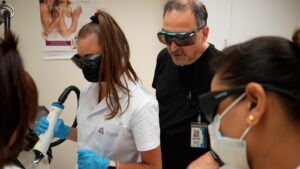Fibroblasts and Their Role in Aesthetic Medicine
 Faramarz Rafie MD / Vancoderm Academy and College (VDA) / Vancoderm Clinic (VDCmed)
Faramarz Rafie MD / Vancoderm Academy and College (VDA) / Vancoderm Clinic (VDCmed)
The structural integrity and elasticity of the skin are primarily maintained by collagen and elastin fibers, yet the synthesis and regulation of these critical proteins are orchestrated by specialized dermal cells known as fibroblasts — the central mediators of skin homeostasis and repair.
Understanding Fibroblast Cells: Structure, Function, and Role in Skin Health
Fibroblasts are specialized mesenchymal cells found primarily within the dermis, the middle layer of the skin. They are considered the architects and engineers of connective tissue, as they produce and maintain the extracellular matrix (ECM) — the structural network that supports skin strength, elasticity, and repair. Under the microscope, fibroblasts appear as spindle-shaped cells with elongated nuclei and multiple cellular extensions, allowing them to connect and communicate within the dermal tissue.
Fibroblast Cell Structure
Fibroblasts contain key cellular components that enable their active role in tissue maintenance and repair:
- Nucleus: Contains DNA and controls protein synthesis, especially for collagen and elastin production.
- Rough Endoplasmic Reticulum (RER): Responsible for synthesizing structural proteins such as collagen, elastin, and glycoproteins.
- Golgi Apparatus: Modifies and packages collagen precursors (procollagen) before secretion into the extracellular matrix.
- Mitochondria: Provide the energy (ATP) required for protein synthesis and cellular repair processes.
- Cytoplasmic Extensions: Allow fibroblasts to attach to surrounding tissue and communicate with nearby cells through biochemical signals.
This internal machinery ensures that fibroblasts remain metabolically active and responsive to physiological changes or injury.
Primary Functions of Fibroblasts
Fibroblasts play multiple essential roles in maintaining healthy skin and connective tissue integrity:
Collagen Production
Fibroblasts synthesize several types of collagen (mainly Type I and Type III), which provide tensile strength and structure to the dermis. Collagen fibers form a dense network that supports the skin’s firmness and resilience.
Elastin Formation
In addition to collagen, fibroblasts produce elastin, a key protein responsible for the skin’s ability to stretch and return to its original shape. Loss of elastin due to fibroblast inactivity leads to sagging and wrinkling.
Extracellular Matrix (ECM) Maintenance
Fibroblasts continuously remodel the ECM by balancing collagen synthesis with the breakdown of old fibers using enzymes called matrix metalloproteinases (MMPs). This dynamic renewal process ensures tissue strength and flexibility.
Wound Healing and Tissue Repair
During skin injury, fibroblasts migrate to the wound site, proliferate, and produce collagen to rebuild damaged tissue. They transform into myofibroblasts, which help contract the wound and close it efficiently.
Growth Factor Secretion
Fibroblasts secrete important signaling molecules such as Transforming Growth Factor-beta (TGF-β), Fibroblast Growth Factor (FGF), and Vascular Endothelial Growth Factor (VEGF). These factors promote angiogenesis (formation of new blood vessels), cell growth, and tissue regeneration.
Cellular Communication
Through chemical messengers and mechanical feedback, fibroblasts interact with keratinocytes, immune cells, and endothelial cells, coordinating overall skin homeostasis and immune defense.
Fibroblast Aging and Decline
As the body ages, fibroblast activity gradually decreases due to oxidative stress, UV radiation, and reduced cellular energy. The decline begins in the mid-30s and becomes more pronounced by the 50s.
- Collagen and elastin production slows, leading to dermal thinning and loss of elasticity.
- DNA damage and glycation further reduce fibroblast efficiency.
- The ECM becomes disorganized, contributing to wrinkle formation, sagging, and delayed wound healing.
Aging and Fibroblast Decline
As we age, fibroblast activity slows down. This means less collagen and elastin are produced, leading to wrinkles, sagging, and loss of elasticity. Environmental stressors such as UV radiation, pollution, and smoking further damage fibroblast DNA and accelerate their decline.
By age 40, the collagen network becomes less organized, and the fibroblasts themselves shrink and lose efficiency — a key reason skin starts to look tired and thin.
How to Stimulate Fibroblasts
The good news is that fibroblasts — the vital cells responsible for collagen and elastin production — can be reactivated through a combination of professional treatments and effective skincare. In clinical aesthetics, several advanced techniques are designed to awaken fibroblast activity and restore youthful skin structure. Microneedling is one of the most effective methods, creating controlled micro-injuries that trigger the skin’s natural healing response, leading to fibroblast activation and collagen remodeling. Radiofrequency (RF) therapy works by delivering heat deep into the dermis to contract existing collagen fibers while stimulating fibroblasts to produce new ones, resulting in firmer, smoother skin. Similarly, laser resurfacing treatments generate controlled thermal damage that encourages fibroblasts to repair, regenerate, and strengthen the dermal layer. Another powerful method, Platelet-Rich Plasma (PRP) therapy, uses the patient’s own plasma rich in growth factors to rejuvenate and reactivate dormant fibroblasts, accelerating tissue repair and collagen synthesis.
Beyond professional procedures, consistent topical support plays a key role in maintaining fibroblast vitality. Vitamin C (ascorbic acid) promotes collagen synthesis by acting as a cofactor in collagen formation, while retinoids stimulate fibroblast proliferation and improve dermal density over time. Peptides, on the other hand, function as biological messengers that send targeted signals to fibroblasts, encouraging them to rebuild and strengthen the extracellular matrix. By combining professional treatments with evidence-based skincare, it is possible to effectively reactivate fibroblasts, enhance collagen production, and achieve visibly firmer, more radiant skin. The Role of the SMAS Layer in Fibroblast Activity
What Is the SMAS?
The SMAS (Superficial Musculoaponeurotic System) is a fibromuscular layer that lies beneath the dermis and subcutaneous fat of the face. It connects facial muscles to the skin and plays a major role in facial expression and contour.
Anatomically, the SMAS is located between:
- The subcutaneous fat (above)
- The facial muscles and deep fascia (below)
Because it links the skin and muscles, the SMAS is essential in lifting, tightening, and rejuvenation procedures — both surgical (facelift) and non-surgical (like HIFU or RF).
Connection Between SMAS and Fibroblast Activity
Although fibroblasts are primarily located in the dermis, the SMAS indirectly influences their function through mechanical tension and stimulation. Here’s how:
Mechanical Signaling (Mechanotransduction)
The SMAS provides tensile support to the overlying skin. When this tension is modified (through lifting or tightening treatments), it sends biomechanical signals upward into the dermis.
These signals stimulate fibroblasts to:
Produce more collagen and elastin
Increase growth factor secretion
Enhance cellular renewal
Thermal and Acoustic Stimulation (HIFU, RF, Ultrasound)
Non-invasive devices like HIFU (High-Intensity Focused Ultrasound) and Radiofrequency (RF) deliver controlled energy to the SMAS layer.
This thermal coagulation not only contracts the SMAS but also creates heat diffusion toward the dermis.
As a result, fibroblasts are activated to remodel collagen and elastin over time.
This process is called neocollagenesis and neoelastogenesis — the formation of new collagen and elastin fibers.
Structural Support for Dermal Fibroblasts
The SMAS acts as a foundation layer. When it becomes lax with age, the overlying dermis loses mechanical support, leading to fibroblast inactivity and reduced collagen synthesis.
By tightening the SMAS, we restore upward tension, which reactivates fibroblast metabolism and improves dermal thickness and firmness.
How SMAS Aging Affects Fibroblast Activity and Collagen Production
The Aging Timeline of the SMAS
The SMAS (Superficial Musculoaponeurotic System) begins to show signs of functional decline typically around the age of 35–40, depending on genetics, lifestyle, and environmental exposure (especially UV damage and smoking).
In the 20s–30s, the SMAS is firm, elastic, and maintains strong tension between muscles and skin.
By the 40s, collagen and elastin fibers within the SMAS start to degenerate, and the connective tissue loses its tone.
After 50, the SMAS becomes lax and stretched, losing its lifting capacity and creating deeper folds and sagging.What Happens
When the SMAS Becomes Inactive
As the SMAS (Superficial Musculoaponeurotic System) layer weakens or becomes less active with age, the mechanical tension it transmits from the underlying facial muscles to the overlying skin gradually decreases. This reduction in tension diminishes mechanotransduction, the biological communication that normally stimulates fibroblasts within the dermis. Without these regular mechanical cues, fibroblasts become less active, producing lower amounts of collagen and elastin, which are essential for maintaining skin structure and elasticity. As a result, the dermal matrix loses density, contributing to the formation of fine lines, wrinkles, and generalized skin laxity. In essence, the natural aging of the SMAS initiates a cascade effect: decreased tension leads to reduced fibroblast activity, which in turn lowers collagen production and accelerates wrinkle formation — a process that can be summarized as: “Aging SMAS → Less tension → Reduced fibroblast stimulation → Less collagen → Deeper wrinkles.”
Indirect Effects on Collagen and Wrinkle Depth
The decline of SMAS function leads to a cascade of changes:
- Loss of support → The skin sags due to reduced attachment.
- Reduced fibroblast metabolism → Collagen and elastin synthesis drop.
- Thinner dermis → Wrinkles appear more visible.
- Weak muscle–skin connection → Facial contours lose definition.
Thus, while fibroblasts age on their own, SMAS inactivity accelerates fibroblast decline indirectly, worsening overall skin aging.
Can SMAS Be Reactivated?
Yes — through mechanical and thermal stimulation techniques, such as:
- HIFU (High-Intensity Focused Ultrasound) → Targets the SMAS layer directly, causing micro-contraction and stimulating fibroblast activity above.
- RF (Radiofrequency) Treatments → Tighten collagen fibers in both SMAS and dermis, improving tension and fibroblast function.
- Facial muscle stimulation → Improves circulation and natural mechanical signaling to the SMAS.
These treatments restore SMAS tension, which in turn reactivates fibroblast communication and promotes neocollagenesis (new collagen formation).
Fibroblasts: The Foundation of Skin Health
Healthy fibroblasts are the foundation of youthful, radiant skin. Supporting them through smart skincare, sun protection, and collagen-stimulating treatments can slow visible aging and promote long-term skin vitality.
 About Vancoderm Academy
About Vancoderm Academy
At Vancoderm Academy and College, we pride ourselves on being a leader in medical aesthetics education in Canada, offering programs that meet the highest standards of training and professional excellence. Our curriculum combines cutting-edge theoretical knowledge with hands-on practice using the latest high-end technologies, ensuring that our students are fully equipped to excel in the rapidly evolving field of aesthetic medicine. We sincerely thank you, our readers, for taking the time to explore this blog and for following our journey in advancing skin, Hair cares, Medical Cosmetic Lasers, Radiofrequency, Microneedling and Medical aesthetic science. Stay connected with us for more insights, tips, and updates by following Vancoderm Academy and College on Instagram, LinkedIn, Facebook, and other social media platforms, and join our growing community dedicated to professional growth and excellence in medical aesthetics.
Thank you for reading, and we wish you continued success, health, and radiant days ahead!

